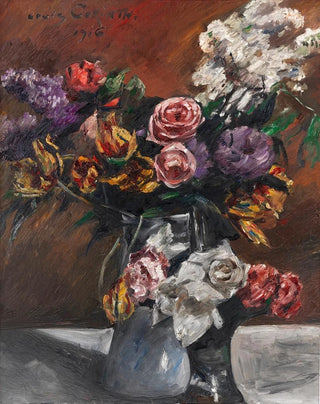Art print | Roses, tulips, and lilacs - Lovis Corinth


View from behind

Frame (optional)
Art print Roses, tulips and lilacs - Lovis Corinth – Captivating introduction
In the vibrant universe of floral painting, "Roses, tulips and lilacs" by Lovis Corinth emerges as a true ode to nature. This piece, bursting with colors and emotions, transports the viewer to a lush garden where each petal seems to whisper secrets of an ephemeral world. The artist, through this composition, invites us to a delicate contemplation, an immersion into the fleeting beauty of flowers. The subtle nuances and delicate light emanating from this canvas create an almost tangible atmosphere, where time appears to stand still.
Style and uniqueness of the work
Lovis Corinth's style is characterized by a bold and expressive approach, blending influences of post-impressionism and symbolism. In "Roses, tulips and lilacs," he manages to capture the very essence of his subjects with unmatched mastery. The flowers, with their vibrant colors, are rendered with such intensity that they seem to vibrate under the viewer's gaze. The brushstrokes, both fluid and dynamic, breathe new life into these natural elements, transforming the painting into a true festival of sensations. Each flower is not only depicted but also felt, evoking complex emotions and buried memories. This marriage of technique and sensitivity makes this work a striking example of art's ability to transcend reality.
The artist and his influence
Lovis Corinth, an emblematic figure of early 20th-century German art, established himself through his unique style and artistic vision. Born in 1858, he evolved in a highly dynamic artistic context, influenced by great masters like Van Gogh and Monet. Corinth developed a distinctive signature, oscillating between expressionism and naturalism, and left an indelible mark on the art scene of his time. His works, often marked by a deep sense of emotion and an exploration of light, testify to a keen sensitivity to the beauty of nature. "Roses, tulips and lilacs" fits into this lineage, revealing not only his talent for floral representation but also his capacity to

Matte finish

View from behind

Frame (optional)
Art print Roses, tulips and lilacs - Lovis Corinth – Captivating introduction
In the vibrant universe of floral painting, "Roses, tulips and lilacs" by Lovis Corinth emerges as a true ode to nature. This piece, bursting with colors and emotions, transports the viewer to a lush garden where each petal seems to whisper secrets of an ephemeral world. The artist, through this composition, invites us to a delicate contemplation, an immersion into the fleeting beauty of flowers. The subtle nuances and delicate light emanating from this canvas create an almost tangible atmosphere, where time appears to stand still.
Style and uniqueness of the work
Lovis Corinth's style is characterized by a bold and expressive approach, blending influences of post-impressionism and symbolism. In "Roses, tulips and lilacs," he manages to capture the very essence of his subjects with unmatched mastery. The flowers, with their vibrant colors, are rendered with such intensity that they seem to vibrate under the viewer's gaze. The brushstrokes, both fluid and dynamic, breathe new life into these natural elements, transforming the painting into a true festival of sensations. Each flower is not only depicted but also felt, evoking complex emotions and buried memories. This marriage of technique and sensitivity makes this work a striking example of art's ability to transcend reality.
The artist and his influence
Lovis Corinth, an emblematic figure of early 20th-century German art, established himself through his unique style and artistic vision. Born in 1858, he evolved in a highly dynamic artistic context, influenced by great masters like Van Gogh and Monet. Corinth developed a distinctive signature, oscillating between expressionism and naturalism, and left an indelible mark on the art scene of his time. His works, often marked by a deep sense of emotion and an exploration of light, testify to a keen sensitivity to the beauty of nature. "Roses, tulips and lilacs" fits into this lineage, revealing not only his talent for floral representation but also his capacity to






